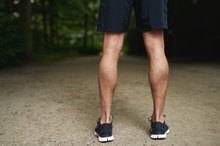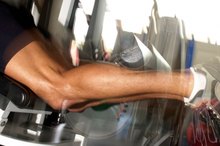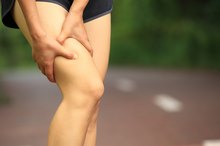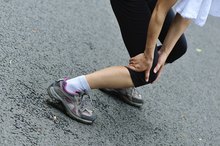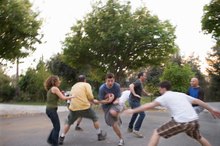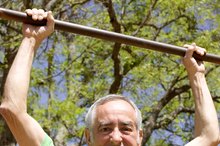What does fact checked mean?
At Healthfully, we strive to deliver objective content that is accurate and up-to-date. Our team periodically reviews articles in order to ensure content quality. The sources cited below consist of evidence from peer-reviewed journals, prominent medical organizations, academic associations, and government data.
- American College of Sports Medicine: Delayed Onset Muscle Soreness (DOMS)
- American College of Sports Medicine: Delayed Onset Muscle Soreness (DOMS)
The information contained on this site is for informational purposes only, and should not be used as a substitute for the advice of a professional health care provider. Please check with the appropriate physician regarding health questions and concerns. Although we strive to deliver accurate and up-to-date information, no guarantee to that effect is made.
How to Treat Severe Muscle Soreness From Weightlifting
Delayed-onset muscle soreness, or DOMS, describes the tight, sore muscles that show up a day or two after an intense weight-training session 1. According to exercise scientist Len Kravitz of the University of New Mexico, DOMS usually peaks within within 24 to 48 hours and resolves itself within 96 hours 3. (reference 4) Proactive treatment can ease your symptoms, but it will not necessarily speed your recovery.
If you are experiencing serious medical symptoms, seek emergency treatment immediately.
Discontinue exercise and allow your sore muscles to rest. The American College of Sports Medicine warns that continuing to exercise with severe symptoms may make the pain worse 1. Refrain from exercising until your symptoms subside.
Hyperextension of the Calf
Learn More
Apply ice to the affected region. Ice can help reduce inflammation and soothe damaged muscle tissue. A 2010 study performed at the University of Wisconsin-LaCrosse found that 30-minute ice treatments applied immediately after a workout -- and then repeated two, four, six, 24 and 48 hours later -- effectively minimized the perceived pain, although it didn't improve the muscle performance.
Seek massage or acupressure therapy. A review of literature published by the Australian Association of Massage Therapists and RMIT University supported massage and acupressure as effective treatments to ease DOMS symptoms.
The Benefits of an Ice Massage
Learn More
Take over-the-counter nonsteroidal anti-inflammatory drugs, or NSAIDs, such as aspirin, ibuprofen and flurbiprofen for temporary pain relief. However, because of the negative side effects of gastrointestinal distress and elevated blood pressure -- along with non-conclusive evidence to support their effectiveness -- NSAIDs are not the optimal choices for treating DOMS.
Tips
When it comes to DOMS, an ounce of prevention can be worth a pound of cure. Kravitz recommends performing a general aerobic warm-up before lifting to elevate your core temperature, and a specific warm-up that mimics the movements you will perform, taking your joints through their full range of motion with little or no weight. The ACSM encourages gradual progression in your exercise program to give your muscles time to adapt.
Warnings
The ACSM warns that reduction of painful symptoms using the above treatments does not equate with recovery, and that muscle damage and reduced muscle function may persist. If severe post-exercise pain is accompanied by excessive swelling, severely reduced function and dark brown urine, you may have rhabdomyolysis, a serious medical condition. Rhabdomyolysis is characterized by a breakdown of muscle membranes, allowing muscle cell contents to leak into your bloodstream. Rhabdomyolysis can lead to severe kidney damage or even death, and symptoms call for immediate medical intervention.
Related Articles
References
- American College of Sports Medicine: Delayed Onset Muscle Soreness (DOMS)
- Journal of the American Society of Nephrology: Rhabdomyolysis
- University of New Mexico: Treating and Preventing DOMS
- Nosaka, Ken (2008). "Muscle Soreness and Damage and the Repeated-Bout Effect". In Tiidus, Peter M. Skeletal Muscle Damage and Repair. Human Kinetics. pp. 59â76.
- Michael Kjaer; Michael Krogsgaard; Peter Magnusson; Lars Engebretsen; Harald Roos; Timo Takala; Savio Woo (2008). Textbook of Sports Medicine: Basic Science and Clinical Aspects of Sports Injury and Physical Activity. John Wiley and Sons. p. 722.
- Armstrong, R. B. (1984). Mechanisms of exercise-induced delayed onset muscular soreness: a brief review. Medicine and Science in Sports and Exercise, 16(6), 529-538.
- Law, R. Y., & Herbert, R. D. (2007). Warm-up reduces delayed-onset muscle soreness but cool-down does not: a randomised controlled trial. Australian Journal of Physiotherapy, 53(2), 91-95.
- Cheatham, S. W., Kolber, M. J., Cain, M., & Lee, M. (2015). The Effects of SelfâMyofascial Release Using a Foam Roll or Roller Massager on Joint Range of Motion, Muscle Recovery, and Performance: A Systematic Review. International Journal of Sports Physical Therapy, 10(6), 827.
- Trappe, T. A., White, F., Lambert, C. P., Cesar, D., Hellerstein, M., & Evans, W. J. (2002). Effect of ibuprofen and acetaminophen on postexercise muscle protein synthesis.a> American Journal of Physiology-Endocrinology and Metabolism, 282(3), E551-E556.
- Schoenfeld, B. J. (2012). The Use of Nonsteroidal anti-inflammatory drugs for exercise-induced muscle damage. Sports Medicine, 42(12), 1017-1028.
- Knitter, A. E., Panton, L., Rathmacher, J. A., Petersen, A., & Sharp, R. (2000). Effects of beta-hydroxy-beta-methylbutyrate on muscle damage after a prolonged run. Journal of Applied Physiology, 89(4), 1340-1344.
- Innerfield, I. (1957). The AntiâInflammatory Effect Of Parenterally Administered Proteases. Annals of the New York Academy of Sciences, 68(1), 167-177.
- Miller, P. C., Bailey, S. P., Barnes, M. E., Derr, S. J., & Hall, E. E. (2004). The effects of protease supplementation on skeletal muscle function and DOMS following downhill running. Journal of Sports Sciences, 22(4), 365-372.
- Atal, C. K., Zutshi, U., & Rao, P. G. (1981). Scientific evidence on the role of Ayurvedic herbals on bioavailability of drugs. Journal of Ethnopharmacology, 4(2), 229-232.
- Velpandian, T., Jasuja, R., Bhardwaj, R. K., Jaiswal, J., & Gupta, S. K. (2001). Piperine in food: interference in the pharmacokinetics of phenytoin. European Journal of Drug Metabolism and Pharmacokinetics, 26(4), 241-247.
Tips
- When it comes to DOMS, an ounce of prevention can be worth a pound of cure. Kravitz recommends performing a general aerobic warm-up before lifting to elevate your core temperature, and a specific warm-up that mimics the movements you will perform, taking your joints through their full range of motion with little or no weight. The ACSM encourages gradual progression in your exercise program to give your muscles time to adapt.
Warnings
- The ACSM warns that reduction of painful symptoms using the above treatments does not equate with recovery, and that muscle damage and reduced muscle function may persist. If severe post-exercise pain is accompanied by excessive swelling, severely reduced function and dark brown urine, you may have rhabdomyolysis, a serious medical condition. Rhabdomyolysis is characterized by a breakdown of muscle membranes, allowing muscle cell contents to leak into your bloodstream. Rhabdomyolysis can lead to severe kidney damage or even death, and symptoms call for immediate medical intervention.
Writer Bio
Michelle Matte is an accomplished fitness professional who holds certifications in personal training, pilates, yoga, group exercise and senior fitness. She has developed curricula for personal trainers and group exercise instructors for an international education provider. In her spare time, Matte writes fiction and blogs.
